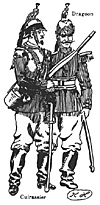
This is an account of the Franco-Prussian mini-campaign played with an opponent through the SWA Aide de Camp service. All communications were undertaken via email with the aim of keeping the momentum of the campaign going through quick exchanges of information.
Campaign set up
The ADC was requested to take on the role of the Prussian cavalry division commander while I would write the orders for the French cavalry division.
The Prussian aim is to leave the campaign map along the side where the River Nied enters near the village of Roupeldange with most of their force intact. Any of the three hexes on this side can be used as a successful exit route. This needs to be achieved within three days.
The French aim is to prevent the Prussians passing the current French line.
Orders
To facilitate the writing of orders an order form was created. The orders form is laid out so that orders are written for each of the two night-time and four day-time periods. The orders form also gives an indication of how the commander wants that unit to react should it come across the enemy. The advantage of the form is that it guides the players to give the relevant information needed for the game to work with the campaign rules.
The ‘Day 1’ order form was emailed to the ADC and I wrote out my orders for the first day using the same format. I was struggling to complete the orders for the two last sessions of the day, that is the afternoon and evening time periods, as I would be uncertain where the Prussians would be by then. When the ADC sent his orders he had experienced the same problem so we took our orders up to the late morning period only, with the aim of writing further orders after that time, as we both sensed a contact with the enemy was imminent.
Campaign Map at Midday
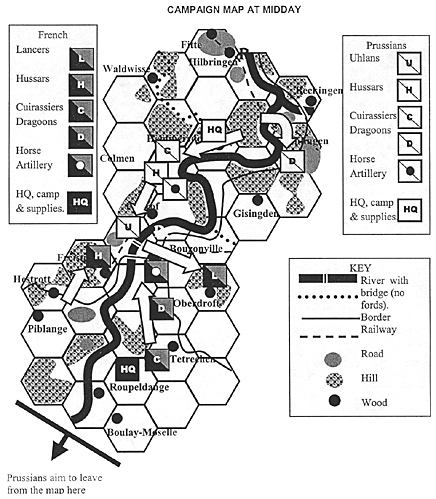
Initial plans and movements
The French initial disposition was poor. A more balanced position was required and this needed to be sorted out before the Prussians arrived on the scene. It was decided that it would be worth the risk of a night march to get the lancers over to the east bank of the Nied and to prepare to move the dragoons over to the west side. The French plan was to hold the villages of Freistoff, Bouzonville and Oberdroft and the nearby bridges over the Nied. This was the thinnest point of the map (allowing for concentration of forces) and secured the bridges to permit troops to be transferred from one side of the river to the other if required. The battle plan was to hold the villages by dismounting the light cavalry and relying on their carbine fire and the horse artillery to weaken the Prussian regiments. Once weakened the heavy cavalry could be used for a decisive attack.
The Prussian commander decided “to make a concentrated thrust down the western bank of the River Nied with the vast bulk of his forces. It is realised that a swift attack must be mounted, and that the bridges to the west and north-west of Bouzonville are vital keys to the success of this plan. Accordingly, the light cavalry regiments, the hussars and uhlans, were instructed to be ready to move at first light in an attempt to seize these bridges. If, as expected, the enemy had taken control of (one or both of) the bridges then the Prussian advance forces would attempt to dislodge them, without exposing themselves to too great a loss, for reinforcements were quickly to hand. It was crucial, however, that we deny (the use of) these bridges to the large French force currently on the eastern bank of the river. The only Prussian force sent east of the River Nied was a token regiment of dragoons, in a conspicuous attempt to draw the attention of the French forces. The Prussian dragoon regiment would be well placed at their flank/rear, and was ordered to harass them, annoy them, attack them, and ensure they divert a considerable portion of the French forces.
Day 1 started at with the night period. It was pouring with rain as the French lancers set off on their night march up the riverbank. The ‘night march’ rule worked against them and they ended up disastrously at Filstrof instead of across the river at Bouzonville. The rain continued into the morning and units were delayed by the poor weather notably the Prussian dragoons and the French heavy cavalry. However, the Prussian uhlans had made reasonable progress and a battle situation arose as they approached Filstrof. The uhlans had orders to attack aggressively if the enemy was encountered while the French lancers were ordered to hold their position … even if it was the wrong position as they now realised in the daylight!
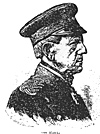 The Filstrof skirmish
The Filstrof skirmish
The uhlans were passing Colmen at 0700 hours when they spotted the French lancers preparing to leave Filstrof. The Prussians quickly formed into line on a low ridge just east of Colmen and began to charge towards Filstrof. The French were lost from view by a small rise in the ground north east of Filstrof for most of the dash but as the Prussians came over this high ground they found the French lancers formed and preparing to receive their attack. The French were at a slight angle enabling the Prussians to overlap their flank but the lancers received the onslaught gallantly. Both sides became disorganised and the melee continued with the Prussians still dominating the higher ground and gradually wearing the French down.
Finally some squadrons of uhlans crept behind Filstrof sealing off the French line of retreat. The Prussian horse artillery appeared and deployed on a spur of raised land just south of Colmen. The French now began to suffer serious casualties and the force was split in two as they attempted to pull back from the fight. A few squadrons cut their way through Filstrof and escaped. The remainder attempted to escape between Colmen and Filstrof but were decimated by shell fire from the Prussian horse artillery battery, which at last had a clear target to fire on. French losses were devastating and a remnant of the lancer regiment is all that escaped the engagement. The Prussian casualties were negligible.
Following this skirmish the lancers fell back rapidly over the bridge to Bouzonville as the rest of the French and Prussian forces slowly approached each other through the continuing rain. By noon it became clear that a battle was imminent and fresh orders were written for French troops and an email message sent off to gather the Prussian orders.
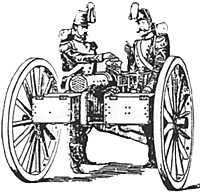 The Battle of Bouzonville
The Battle of Bouzonville
The French orders were to get the dragoons over the river and then work with the hussars. Basing themselves in Fristoff they were to lure the Prussians towards the bridges. The horse artillery were to fire on any forces entering this position as a first priority. The cavalry were then to attack. If the enemy were forced back then return to positions at Fristoff and repeat the operation if required. At Bouzonville the cuirassiers were to fend off the dragoons with the support of the dismounted lancers and horse artillery.
The Prussians intended to hold the road bridge with dismounted uhlans. The cuirassiers were to take and hold the railway bridge. The hussars were to move around the flank and attack the French hussars working with the cuirassiers in this respect. The horse artillery was to provide support for these units. The Prussian dragoons were to continue with the planned diversionary movements, and were to threaten the French forces wherever and whenever possible. Although considerably outnumbered they must be “prepared to act aggressively if circumstances are in our favour.”
At 1200 the storm that had been threatening all day finally broke. The Prussian cavalry and artillery began their soaking journey through this as the uhlans dismounted near the bridge and found places to shelter from the rain!
Soon after the French cavalry began its advance. The dragoons moved to the railway bridge and began to organise themselves into small groups to negotiate the bridge crossing. The hussars began their slow advance towards the uhlans at the road bridge. The French horse artillery drove right up to the river bank and unlimber to fire across at the dismounted uhlans. Through the driving rain they were just visible at this short range. But their fire was poor and ineffective.
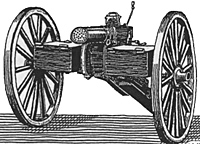 By 1300 the storm had blown out but a heavy rain persisted. The Prussian hussars made their way towards the road bridge rather slowed by the muddy ground while the Prussian cuirassiers and horse artillery arrived at Filstrof. The French horse artillery fire was now becoming effective causing the uhlans to take action. They advanced to the bank of the river and opened a devastating fire with their carbines on the artillery stationed on the opposite bank. The French artillery quickly took considerable casualties and the guns were silenced and abandoned. As the rain lightened the Prussian cuirassiers and horse artillery joined the hussars at the road bridge. The horse artillery unlimbered to help defend the bridge from attack and prevent the French carrying away their abandoned guns from the far bank.
By 1300 the storm had blown out but a heavy rain persisted. The Prussian hussars made their way towards the road bridge rather slowed by the muddy ground while the Prussian cuirassiers and horse artillery arrived at Filstrof. The French horse artillery fire was now becoming effective causing the uhlans to take action. They advanced to the bank of the river and opened a devastating fire with their carbines on the artillery stationed on the opposite bank. The French artillery quickly took considerable casualties and the guns were silenced and abandoned. As the rain lightened the Prussian cuirassiers and horse artillery joined the hussars at the road bridge. The horse artillery unlimbered to help defend the bridge from attack and prevent the French carrying away their abandoned guns from the far bank.
By 1400 the sky had brightened and the weather was to remain fair for the rest of the day. The Prussian horse artillery opened fire on the French dragoons who were still near the railway bridge and rather disorganised. They suffered moderate casualties and retreated away from the bridge in disorder seeking some cover from the Prussian shells. Immediately after this the Prussian hussars and cuirassiers charged at the French hussars now half way between the bridge and Freistoff. The hussars seemed to take the onslaught with courage and few casualties but were rolled back by the combined weight of the heavies and lights.
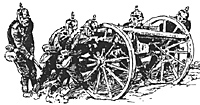 Then suddenly the French morale snapped and the hussars fled past Freistoff and away along the riverbank. The remnant of French lancers rode into Bouzonville and dismounted to take up defensive positions in the village. The French dragoons busied themselves with reorganisation now they were out of sight of the Prussian guns. The Prussian horse artillery opened fire on Bouzonville in an attempt to drive out the French lancers.
Then suddenly the French morale snapped and the hussars fled past Freistoff and away along the riverbank. The remnant of French lancers rode into Bouzonville and dismounted to take up defensive positions in the village. The French dragoons busied themselves with reorganisation now they were out of sight of the Prussian guns. The Prussian horse artillery opened fire on Bouzonville in an attempt to drive out the French lancers.
At 1500 the Prussian hussars had reorganised themselves and set off in pursuit of the French hussars to ensure they would not reform and to secure the exit route for the division. The Prussian horse artillery continued to fire on Bouzonville but the small shells of the light guns had little impact on the stone walls of the village. The Prussian dragoons arrived on the scene heading parallel to the railway line towards Bouzonville. They bypassed Bouzonville, under fire from the French lancers, and charged at the French dragoons. The French dragoons already weakened by the Prussian artillery suffered serious casualties and fell back in disorder which turned into a rout as the Prussians pursued them.
The Prussian dragoons abandoned their pursuit at 1700 as the French cuirassiers came into sight and decided to fall back to the road bridge to enable their escape. Passing Bouzonville again the fire of the French lancers at last began to tell and the dragoons suffered moderate casualties.
At 1730 the French cuirassiers moved up towards Bouzonville threatening the Prussian dragoons
It was dusk at 1800 the Prussian dragoons moral began to weaken. With the threat of the fresh French cuirassier unit about to attack and the continued harassing fire from the lancer’s carbines the Prussian dragoons began to break up and cross over the road bridge to safety. The Prussian horse artillery covered their retreat by firing on the French cuirassiers causing them to fall back behind Bouzonville to find cover.
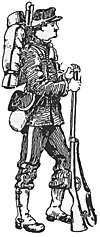 Campaign Results
Campaign Results
That night and early next morning the Prussians were able to move along the bank of the River Nied having succeeded in breaking through the French line. They could now begin their attacks on the French supply lines.
The ADC had provided clear and workable orders which, combined with a little luck on the dice, had won a decisive Prussian victory. My thanks to Geoff Barker for his help as the ADC in this mini-campaign.
Email campaigns
Through this project I have found that email provides a much quicker and easier medium of communication for ADC work. Full colour images with fine details can be transmitted easily which is ideal for sending maps and photos. There are some elements of the wargames I will modify for future email mini-campaigns as a result of this experiment:
- The time saved compared to postal mail means that shorter time periods for the campaign orders can be used; 3 hours rather that a day.
- I was not always prompt in replying to emails and I would suggest setting up an agreed timetable for email responses to keep the game flowing. This allows both parties to know when to expect the next message and so check their mail.
- A web-camera might also be advantageous permitting instant pictures of the battle to be emailed as it unfolds on the wargames table.
Back to Table of Contents -- Lone Warrior # 143
Back to Lone Warrior List of Issues
Back to MagWeb Magazine List
© Copyright 2003 by Solo Wargamers Association.
This article appears in MagWeb.com (Magazine Web) on the Internet World Wide Web.
Other military history articles and gaming articles are available at http://www.magweb.com
